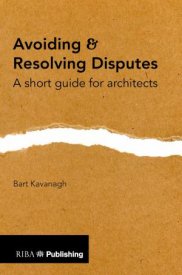Main author
Michael BrooksAvoiding and resolving disputes - review
‘Avoiding and resolving disputes: A short guide for architects’
Bart Kavanagh
Published by RIBA Publishing (May 2017)
In 2013, an NBS survey, the National Construction Contracts and Law Survey, found that 30% of firms had been involved in at least one dispute in the previous 12 months. As a consequence, there is enormous interest in construction disputes but this tends to focus on dispute resolution techniques rather than how to avoid them.
Bart Kavanagh, a chartered architect and non-practising barrister with more than 35 years in the industry, has written an excellent new pocketbook that will serve as a worthwhile primer for architecture students as well as a refresher for professionals.
The book provides a straightforward and easy-to-read guide to the essentials of construction disputes, which can often be ‘foreign territory’ for architects. It tackles the risks that practitioners may face, steps that can be taken to minimise them, and what to do when such risks develop into a dispute.
The book covers the typical reasons for disputes that tend to arise between parties on a project, and highlights some tips for avoiding them in the first place. Issues can often be informally negotiated as they arise, as the book explains, but sometimes this will be insufficient and full-blown disputes need to be handled more formally.
Throughout, the author arranges the topics in an accessible way with helpful checklists and important cases to remember. The most common alternative dispute resolution (ADR) options are described, from mediation to adjudication to litigation.
This succinct, no-nonsense guide will come in handy for architects of all levels of experience, as well as other professionals such as contractors or quantity surveyors who feel like familiarising themselves with the core concepts and processes.
To purchase the book, see RIBA Bookshops.
[edit] Find out more
[edit] Related articles on Designing Buildings Wiki
Featured articles and news
International Electrician Day, 10 June 2025
Celebrating the role of electrical engineers from André-Marie Amperè, today and for the future.
New guide for clients launched at Houses of Parliament
'There has never been a more important time for clients to step up and ...ask the right questions'
The impact of recycled slate tiles
Innovation across the decades.
EPC changes for existing buildings
Changes and their context as the new RdSAP methodology comes into use from 15 June.
Skills England publishes Sector skills needs assessments
Priority areas relating to the built environment highlighted and described in brief.
BSRIA HVAC Market Watch - May 2025 Edition
Heat Pump Market Outlook: Policy, Performance & Refrigerant Trends for 2025–2028.
Committing to EDI in construction with CIOB
Built Environment professional bodies deepen commitment to EDI with two new signatories: CIAT and CICES.
Government Grenfell progress report at a glance
Line by line recomendation overview, with links to more details.
An engaging and lively review of his professional life.
Sustainable heating for listed buildings
A problem that needs to be approached intelligently.
50th Golden anniversary ECA Edmundson apprentice award
Deadline for entries has been extended to Friday 27 June, so don't miss out!
CIAT at the London Festival of Architecture
Designing for Everyone: Breaking Barriers in Inclusive Architecture.
Mixed reactions to apprenticeship and skills reform 2025
A 'welcome shift' for some and a 'backwards step' for others.
Licensing construction in the UK
As the latest report and proposal to licence builders reaches Parliament.
Building Safety Alliance golden thread guidance
Extensive excel checklist of information with guidance document freely accessible.
Fair Payment Code and other payment initiatives
For fair and late payments, need to work together to add value.
Pre-planning delivery programmes and delay penalties
Proposed for housebuilders in government reform: Speeding Up Build Out.
High street health: converting a building for healthcare uses
The benefits of health centres acting as new anchor sites in the high street.


























